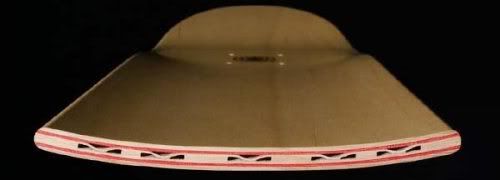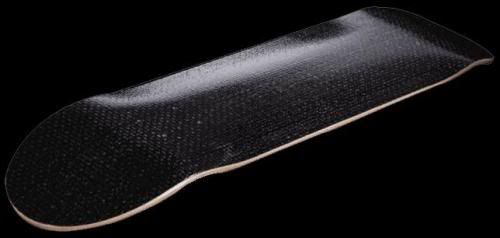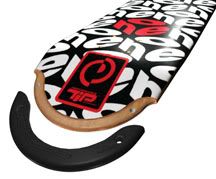
This was "supposed" to be a super, long-ass article on every "new technology" in the skateboard marketplace today, the merits and demerits of each of them... what works, what doesn't, and why. But, truth be told, I'm just a little bit bored of all that stuff. And besides, there's so much marketing bullshit and foggy "engineering" going on, that I just didn't even wanna discuss it all. Let alone, lend any of it any sort of "legitimacy" by actually being featured in the solitary life. So, let's just keep it really raw, real, and straightforward, and focus on the shit that actually works, okay...?
Truthfully, there's only three "deck technologies" that mean anything at all out there. And, everything else is pretty much garbage. Let's get that laid down, right off the bat. The three "technologies" that work are generally:
- Hollow cores (because of their light weight),
- Surface strengtheners (for long-lasting durability), and
- Tip reinforcements (for added pop, and even more durability).
Let's start with hollow cores. Like, the Element Helium construction, for example. Or, Lib Technologies' new Glory Hole construction. Hollow cores obviously remove materials from the board. Which also, removes mass. Which saves weight. And, as far as street decks go, lighter is [usually] better.

Here's a cross-sectional view of the Element Helium construction. Note that the "air chambers" are in the dead-center of the board, where they won't compromise the overall strength of the deck. The basic idea is a lot like corrugated cardboard; with the corrugated center, corrugated cardboard is a lot stiffer than regular 'ol card stock. This is the same idea, but just a different application.
Any time that we're "removing stuff" from a deck, we want to remove it from the center of the board, if and when it's possible to do so. Why? Because, the center of the deck is the lowest-stress area of the deck. Obviously, the center of the deck is also the lowest-abuse area of the deck, too. So, removing materials from the middle of the deck, is smart engineering. So: Good job, Element Helium.
Now, let's move on to surface strengtheners. Foundation's Fiberlam/Fiberprime, Toy Machine's Fiberlam/Fiberprime, SMA's Blackbird, and Santa Cruz's PowerLyte constructions are perfect examples. Any time that you use any sort of "composite" material (like, carbon fiber), you want that material to be on the outside of whatever it is that you're making. That's why most things that use carbon fiber... like race car bodies, jet airplane components, the hood of your tricked-out Honda Civic, or your dad's bicycle frame and forks... have the carbon fiber visible, on the outside. Only a total jackass would put carbon fiber in the middle of something... but, jackass skateboard companies do this all the time. Why? I don't know, man. You'll have to ask them...


Here, we have several views of a Foundation Fiberlam deck. Note how the Fiberlam material is on the top and the bottom of the deck. Any time you're using advanced composite materials, you want those materials to be as far from the center of the board as possible. This is just basic engineering 101; any composite-use handbook is gonna tell you that! Obviously, putting them on the very top and bottom of the deck is as far away from "center" as you can possibly get. So Foundation gets it right, where many others get it so, so wrong...
Lastly, we have tip reinforcements. Never Summer is doing this, on their longboards. Lib Technologies has also been doing this for quite a while on their skateboard decks. And, there's a group of companies that use something called the Performance Tip System ("P-Tip", for short), where the tip is removeable/replaceable (unlike the Libs and Never Summers, where it's laminated right into the board, and thus, not replaceable). These "tips" all do the same thing: They increase pop, while eliminating chipping.

Here's a typical "Performance Tip" deck. This time it's by One Skateboards, a small company out of Philly run by the ever-illustrious AJ Kohn. Whatever brand you choose (and, there are definitely quite a few to choose from, at this point), the basic principle always remains the same: A harder, tougher tip creates more pop, and less chipping. Pretty bonus, considering that "more pop" and "less chipping" is on almost every skateboarders' wish-list.
Like a Fiberlam, these tips are usually made out of some sort of composite material that's a lot harder, and far more durable, than wood. Think of it as a bumper for your deck. Or: Think of snowboards, where plastic sidewalls and composite tips have been used to increase pop and durability since the 1980's, and have currently found their "ultimate" form in boards like Burton's Vapor, a smoke-weight, bulletproof, and uber-responsive deck that's almost entirely made out of lightweight cores and surface composites.
History:
The really interesting thing about these "new technologies" is that, all of them have been with us for decades in one form or another. I've heard that Bennett had a flyweight deck all the way back in the 1970's that had a drilled-out, foam-filled core. Santa Cruz also offered Foam Core decks in the mid-'80s.
The Fiberlam is obviously descended from the old G&S Fibreflex decks that were common... maybe even, "pretty popular"... back in the early '70s, and continue to be to this very day. The only real "difference" between a Fibreflex and a Fiberlam being, of course, the exact weaves and epoxies that are being used. But still, the premise remains the same: Using a composite on the top and bottom of a deck, makes that deck stronger.
As for hard-composite "tips", these are clearly descended from the add-on, plastic "tail bones" that many [beginner] skaters added to their decks in the '80s. Like rails and noseguards, the idea was to protect the board from tail-dragging the board to death. The only real "advance" here is again, the materials being used, and the fact that it's neatly flush-fit onto a specially-routered deck.
The Future:
So: What Is The Future Of These "New" Technologies...? The funny thing is, if you took an Element Helium core, added a Performance Tip, and laid it up with Fiberlam on the top and bottom... you'd pretty much have the ultimate street deck. As it would be the very best in light weight, high strength, chip-proofing, and awesome "pop".
So, you tell me: Who's gonna figure it out first, and get this thing to market before the next chump does...? Let's get this thing done already! The market awaits, guys...
